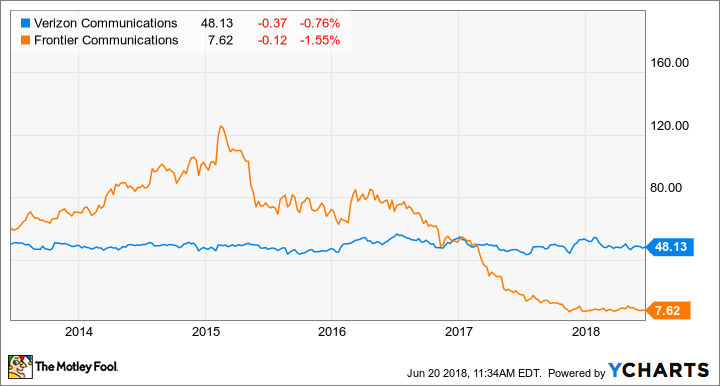Better Buy: Verizon Communications Inc. vs. Frontier Communications
Verizon (NYSE: VZ) and Frontier Communications (NASDAQ: FTR) are two companies in dramatically different positions. The first is a towering giant in the wireless space trying to adapt to a changing market, and the second is a struggling cable and internet provider trying to find a path to growth.
Both are in the subscription business, but aside from that, the two companies are very different. If you own Verizon, it's because you believe the company can continue its dominance. Shareholders in Frontier likely either believe the company's long, arduous path to growth will succeed, or that it will be purchased at a premium over its current price.

Verizon has managed to grow its subscriber counts. Image source: Getty Images.
The case for Verizon
Verizon has continued to grow its wireless business despite heavy price-based competition from Sprint and T-Mobile. In its most recent quarter, the wireless leader added 260,000 retail net customers. It also improved its earnings from $0.84 in the first quarter of 2017 to $1.11 in Q1 2018.
To continue that, the company has changed its long-term plans. It still touts the quality of its network, but it has also acquired a portfolio of content products (including AOL and Yahoo!) that, in theory, it can use to entice customers to stay on its wireless platform in the future.
"We began 2018 with strong momentum, and we expect it to continue throughout the year," said outgoing Verizon CEO Lowell McAdam in the first-quarter earnings release. "We are positioning Verizon for long-term growth while executing our strategy today and leading the way for the next cycle of growth for the industry."
In addition to content, a key part of the Verizon strategy, which will be led by incoming CEO Hans Vestberg, is building out a 5G network. That's a significant investment, but it will allow the company to leverage its content brands and perhaps launch streaming video products.
The case for Frontier
Frontier has been struggling since it purchased 2.1 million broadband connections, and 1.2 million FiOS video subscribers from Verizon in California, Texas, and Florida for $10.54 billion in April 2016. That deal was a calculated move by the company to add scale in order to spread expenses over a greater number of customers.
That part has worked. The company has achieved over $1 billion in cost savings with plans to achieve nearly $400 million more. The problem is that Frontier has lost customers in every quarter since it purchased the Verizon properties. Those losses have slowed, but there has been no sign that they are going to stop or reverse. CEO Dan McCarthy does not see it that way.
"In the first quarter we achieved growth in consumer revenue, reflecting the early results of the substantial initiatives we have under way across the company," said CEO Dan McCarthy in the Q1 earnings release, continuing:
We are also extremely pleased with the continued improvement in subscriber trends in our California, Texas, and Florida (CTF) markets, most notably that we have achieved our first quarter of positive FiOS broadband net additions. We've also begun to improve the trends in the legacy markets.
That's rosy view, but McCarthy has had to work hard to keep the company afloat due to its debt. He has been adept at getting lender concessions, but he's also eliminated Frontier's dividend and been forced to enact a reverse stock split.
Image source: YCharts.
Which is a better buy?
Verizon is a safer buy. The company is currently trading at roughly the middle of its 52-week average, and even if its stock languishes, it pays a dividend and will almost certainly continue to do so in the long term.
The only argument for Frontier is that it has more upside potential. It could be bought, or it could manage to reverse its losses. Neither of those scenarios is likely, and that makes a bet on the company, well, a bet (and one with long odds).
Neither company is really all that attractive. Verizon is a better choice, but it faces its own challenges as competition comes from a possible merged T-Mobile and Sprint. Still, Frontier has a very real possibility of shrinking its way to bankruptcy. That makes it a much bigger risk with only a small chance of upside.
More From The Motley Fool
Daniel B. Kline has no position in any of the stocks mentioned. The Motley Fool owns shares of Verizon Communications. The Motley Fool recommends T-Mobile US. The Motley Fool has a disclosure policy.

 Yahoo Finance
Yahoo Finance 
